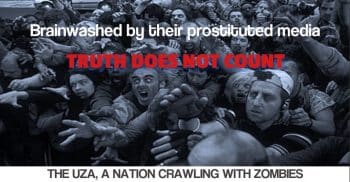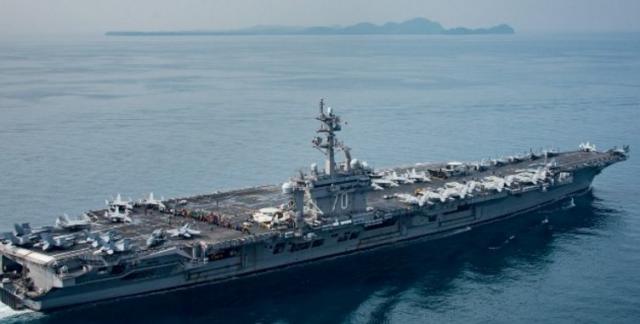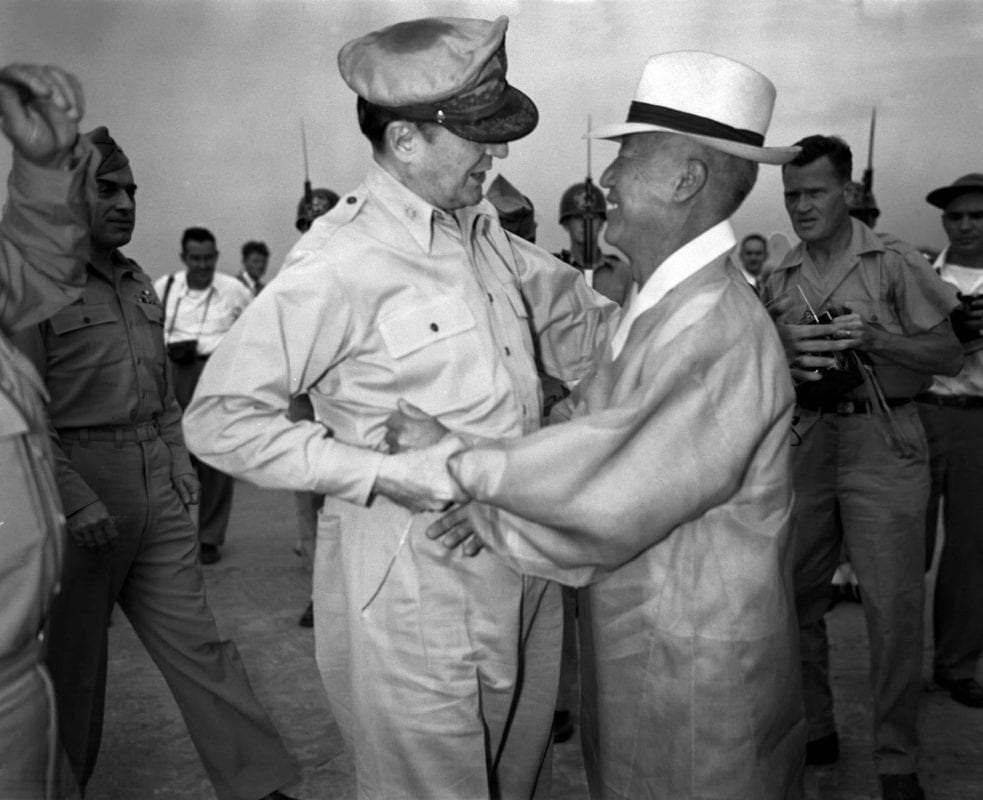History and Hypocrisy: Why the Korean War Matters in the Age of Trump
What media whores like Charlie Rose don't know, don't care to know, or will never tell you. Guaranteed.
(AND DON'T EXPECT THE NEW YORK TIMES TO TELL YOU, EITHER.)
COVER IMAGE ABOVE: OH, WHAT A LOVELY WAR! American liberals and the public at large still hail the TV sitcom M.A.S.H. as an example of great progressive television, but the series' essentially dishonest and often frat-humour plots whitewashed the illegality and brutality of American actions in the Korean peninsula, portraying the Americans as good-natured and generous to the native population. Hollywood, as usual, hid the ugly face of US imperialism. (Still from the series, 1972.)
The DPRK’s recent missile test is a “provocation” according to US state sources. A provocation indeed. Firing things into the air that go bang is clearly not a nice thing to do. People really should ease up on things that explode. I mean somebody could get hurt.
Unfortunately for the Americans, when it comes to making things explode they themselves are hardly innocent. Trump’s recent bombardment of Afghanistan and Syria is a case in point. Maintaining considerable armed forces on the Korean peninsula and making a lot of threatening noise about an “armada” is another. To thus accuse the North Koreans of “provocation” is akin to me objecting to foul language after donning a t-shirt with “I like violence” written across the front and brandishing a knife at complete strangers. It simply makes no sense.
You’ll be lucky to find much in US foreign policy that makes sense, however. The popular media doesn’t help. Spurning any semblance of objectivity at every turn, much of the western press would have you believe that the DPRK is populated by people who are simply insane, all marching in unison to the whims of their stereotypical Bond villain of a leader. The at times racist narrative, so eagerly lapped up by swathes of the freedom loving public, is simplistic to the point of being painful. All the same it persists.
The grotesque level of artificially maintained ignorance in the United States—which presidents share, in particular an ignoramus maximus like Trump or Bush2—is literally a crime of complicity in the innumerable depredations of the US global empire.
Let’s get a few things out in the open. The DPRK is not the aggressor here. Their nuclear program is hardly in the final stages, and given the recent news of yet another failed test it seems unlikely Pyongyang will be able to develop a reliable mid-range ICBM for some time. Their conventional forces, although sizeable, are also generally in possession of somewhat antiquated technology. Aside from a few outbreaks along the border with the south, the DPRK has never actually engaged in open conflict with any power, at all, since the signing of the armistice that ended the Korean War. All in all this is not a country that’s looking for a brawl for the pure sake of it.
The same cannot be said for others. Since the birth of the DPRK the US has attacked numerous countries across the globe, killing literally millions of people, including fighting a major conflict on Korean soil just five years after using WMDs on Japanese cities. Ever eager to safeguard democracy, the US currently has well over a hundred thousand troops stationed in myriad parts of the world, with over twenty thousand in South Korea itself. American nuclear weapons are able to decimate entire nations at will, with the “progressive” President Obama having pouring over a trillion dollars into their redevelopment and enhancement. All in all this is a nation well accustomed to violence.

Constant disinformation about foreign issues and pervasive jingoism have stunted the empathetic imagination of most Americans. How would THEY react if a huge superpower had killed up to 1/3 of their population and flattened all their cities and infrastructure? Considering the obsession with 9/11, which involved less than 3,000 victims, we can only imagine the magnitude of their psychic wounds. But such elementary sense of fairness is lacking when judging North Korea or similar nations devastated by US attacks.
The hard truth is that the DPRK has been under myriad sanctions by the US for the vast bulk of its existence, with the fixation on the recent nuclear issue being a sideshow to gloss over an ongoing policy to ostracise, isolate and generally defame the DPRK as a habitual, indeed pantomime, villain. The fact that Korea has been divided by an invading force is rarely scrutinised, nor are the frequent attempts to intimidate Koreans into obedience, from incessant military drills to proposals to withhold food aid and potentially starve millions of people. The current tensions can only be understood within the context of this very unequal, very predatory, context.
A Troubled Past
History matters. The standard narrative on the Korean War of 1950-53 is that the United Nations was forced to commit military forces only after the malevolent Kim Il Sung ordered an entirely unprovoked assault on the south. Like so much else when it comes to both politics and history, the mainstream perspective is convoluted, if not just entirely wrong. The truth of the matter is that, after initial division between north and south in the wake of the defeat of the Japanese occupation, skirmishes between Seoul and Pyongyang had been going on for some time, with the former having carried out several notable (and distinctly hostile) incursions.
Spurning any semblance of objectivity at every turn, much of the western press would have you believe that the DPRK is populated by people who are simply insane, all marching in unison to the whims of their stereotypical Bond villain of a leader.
For historians such as David Reynolds, some one hundred thousand Koreans had already been killed in border fighting and uprisings in the south prior to the outbreak of formal hostilities. Indeed, analysts have gone as far as to hypothesise that the situation in 1950 degraded so rapidly precisely due to the ROK assault on the north Korean town of Haeju, something that prompted the DPRK to consider redoubled measures against an increasingly aggressive neighbour.

Chinese soldiers during Korean conflict. High motivation, iron discipline and numbers neutralized the US-led attack and its igh-tech weapons.
The US were also not about to let a golden opportunity slip by. After losing influence across much of East Asia with the defeat of the pro-US Kuomintang in ’49 (itself a deeply corrupt and authoritarian entity with a propensity for massacring its own people) Washington found itself looking for opportunities to regain lost ground. A reunified Korea under western influence seemed like an eminently desirable scenario. Korea could not be allowed to unite on its own terms, given US fears of left-wing success in national elections. The outbreak of hostilities on the peninsula were too good an opportunity to pass up.
The Americans moved fast. Refusing to wait for authorisation from an already fractured UN Security Council, the US committed itself to an extensive and protracted campaign, ultimately overrunning much of northern Korea before being driven back by the intervention of substantial Chinese forces. In the process, the US inflicted numerous war crimes against the general population, with the air force targeting civilian and military centres with well over six hundred thousand tons worth of bombs and thirty thousand tons of napalm.
By the end of the war, General MacArthur’s order to “destroy every means of communication and every installation, and factories and cities and villages” had been carried out. Much of the DPRK, alongside swathes of the ROK, were in ruins, with US aerial bombardment ensuring the vast majority of urban areas were decimated and their populations either dead or displaced.
Pyongyang was effectively levelled, having gone from being home to some half a million citizens in 1950 to having just two structures left intact three years later. In the south, Seoul changed hands a total of four times in just nine months, with its “liberation” ensuring only the capital building and a railway station were left intact. Over twenty percent of the northern population is believe to have been killed, many of them civilians blown to pieces or immolated in napalm during the incessant pulverisation of their homes. Well over a million southerners also lost their lives.
“We burned down just about every city in North Korea and South Korea both,” claimed one young American officer, Curtis LeMay, “we killed off over a million Korean civilians and drove several million more from their homes”. This was no idle boast. In ’52, William Douglas, himself Associate Justice of the US Supreme Court, visited the war-torn nation to see such sights first-hand, remarking “”I had seen the war-battered cities of Europe; but I had not seen devastation until I had seen Korea”.
Massacre at No Gun Ri
[dropcap]D[/dropcap]eath from above was only one side to the punishment inflicted upon the troubled nation. On the ground, American soldiers soon developed a sense of brazen contempt for the indigenous population, engaging in myriad acts of thuggery against civilians unlucky enough to get in the way.
Those suspected of harbouring political sentiments out of style with the southern authorities found themselves in hot water, with some one hundred thousand potential dissidents being murdered over the course of the conflict. Mass killings and the wholesale slaughter of entire prison populations by ROK security forces were not unknown.

South Korean investigators disagreed with Pentagon findings, saying they believed 7th Cavalry troops were ordered to fire on the refugees. (military.wikia.com)
The plight of war refugees was unsurprisingly harsh. In fact it was here that US ground forces carried out one of their most notorious actions of the entire war, slaughtering several hundred civilians being forcibly driven from their homes around the village of No Gun Ri.
Many of the inhabitants of this region had already found their homes set alight, with one particular group being “evacuated” by American troops also in the habit of beating up and occasionally shooting individual Koreans for presumed infractions. Aside from the casual murderousness of the GIs, the refugee’s journey south was uneventful until the middle of the next day when, finding themselves bereft of their gracious escorts, they were suddenly attacked by US aircraft.
The villagers, dazed and frightened, attempted to flee the bombs and bullets only to inadvertently approach positions manned by US soldiers. The response from the troops was to open fire, apparently being ordered to remain on alert for “civilian clad” infiltrators attempting to pass through American lines. Whatever their reasons, the soldiers hosed the panicked column with machine gun, rifle and mortar rounds, killing a sizeable amount of civilians and causing others to flee.

Australian soldier meeting local kids. The Brits and their dominions were dragged, as usual, into the American imperial assault.
Seemingly not content, US soldiers then rounded up survivors and herded them under a nearby bridge, in the process shooting several deemed too badly hurt to be moved. After forcing some three hundred persons into confinement in this way, the Americans opened fire yet again, ripping in to the Koreans from both sides of the bridge with small arms and artillery.
“We was holding that rail-road bridge to keep them from coming across that,” claimed one Melvin Durham of F Company, 7th Cavalry, himself cited in the seminal text, The Bridge at No Gun Ri. “But those people – there was women, children, old people – we had to eliminate them…our orders was to start opening fire and when we did, there wasn’t nothing standing but a couple of cows. We fired for about an hour, an hour and a half.”
Durham and company weren’t messing around. Few of those trapped under the bridge survived the onslaught, with entire families, infants and elderly included, dying among the detritus of shattered masonry and pulverised flesh. One strapping young patriot, clearly with a mind for America’s glorious colonial roots, claimed “it was like an Indian raid, back in the old days. We just annihilated them”. Another, this time a staff sergeant, likened the action to a “feeding frenzy…guys were shooting because they hadn’t shot before, and they had permission to shoot…it’s like ‘Hey, shoot at anything that moves out there.’”
This wasn’t an isolated incident. Additional orders issued to other US army and air units were clear enough. One such memo, detailed in the 2002 documentary “Kill ‘Em All”, declared officers had “complete authority in your zone to stop all civilian traffic. Responsibility to place fire on them (and) to include bombing rests with you”. Another more direct order instructed units that “all refugees are fair game. Refugees will be considered (the) enemy and dispersed by all available fire including artillery.”
One reluctant soldier, having the temerity to display something of a conscience when it came to such directives, recalled an unusual morale boosting technique from his commanding officer. Rather than grappling with the ethical complexities of murdering innocent people, the officer in question instead held a gun to the soldier’s head, demanding that he “kill ’em…or I will kill you myself” and begrudging him for “disobeying a direct order”.
Others were not so restrained. “There was a lieutenant screaming like a mad man to fire on everything,” recalled one Joe Jackman, himself a war vet present at No Gun Ri. “Kids, there was kids out there, it didn’t matter what it was. Eight to eighty, blind, crippled or crazy, they shot ’em.”
In addition to mass bombardment and repeat atrocities, the US had other joys in store for Korea. After the Chinese had crossed the border in late 1950 and defeated the US Eighth Army in open battle, the use of atomic weapons became a serious possibility. Clearly irked by the audacity of the Chinese, General MacArthur entertained an ambitious plan to target both Korean and Chinese cities with WMDs, in the process ideally creating a belt of irradiated wasteland between the two nations that would deter any further meddling from Beijing.
He wasn’t playing games. “I would have dropped thirty or so atomic bombs…strung across the neck of Manchuria,” claimed the General, in an interview published after his death. “(I’d) spread behind us, from the Sea of Japan to the Yellow Sea, a belt of radioactive cobalt…it has an active life of between sixty and one twenty years. For at least sixty years there could have been no land invasion of Korea from the north. My plan was a cinch.”
He was probably right. Fortunately his scheme was never approved. Yet such heroics were not to be confined to east Asia. Just three years after the end of hostilities in Korea, the Cold War was still heating up, with the US preparing an extensive list of targets for nuclear bombardment in multiple countries. Ranging from locales as disparate as Warsaw and Beijing, the Americans cited major urban zones as priority targets for destruction, with the total elimination of their high civilian populations the desired outcome.
One small problem presented itself. Given the nature of the weapons to be deployed, the possibility of collateral damage in allied states was a sizeable possibility. Such a scenario doesn’t appear to have caused too much worry for US strategic planners, however, with East Berlin soon being targeted by over ninety atomic weapons as part of a policy of “systematic destruction” that would have also wiped out allied West Berlin and devastated swathes of Europe. The well-being of their own partners, not to mention the lives of millions of men, women and children in multiple nations, from Germany to China, were eminently expendable in the face of US interests.
A cheap shot would be to argue that this is all “ancient history”. Of course, those making such a claim are almost certainly safely ensconced within the US itself, always way out of the line of fire and comfortable in the precedent that catastrophic violence is something that Americans inflict on foreigners rather than the other way around.
Claims that such matters are “history” also make the crass assumption that there is a point of sudden disconnect between US policy then and now, itself a rather clumsy notion that ignores the reality of American aggression over the past several decades. Planning to murder (and in the case of Korea actually doing so) millions of people isn’t something that can be conveniently dismissed by uttering tired maxims such as “forgive and forget”. The current belligerence directed towards Korea highlight this.
Again, history matters. DPRK citizens today make frequent mention of the Korean War. In some instances many families will yet retain a living link to that conflict, with scenes of horrific suffering and sweeping destruction a yet present memory. Even those without relatives around to recall the 1950s will be reminded of the tender touch of US foreign policy every time they go outside, with the near total levelling of many urban centres ensuring that most buildings in modernity are merely decades rather than centuries old.
It would be a serious mistake to assume this finds no echo in Korean politics. Every time news hits of the latest US offensive abroad, from Iraq to Afghanistan to Libya and Syria, Koreans will be further reminded of their own painful past. The continued presence of sizeable American military forces on the Korean peninsula won’t help. Washington’s redoubled threats and moronic macho talk about “looking for trouble” won’t help either.
Declarations from Pyongyang as to sovereignty, retaliation, self-reliance and military prowess will, however, make sense to a people long accustomed to either being the underdog or facing outright annihilation. There is nothing “crazy” about this. Only the most deluded of western cynics could claim Koreans resent the western powers purely because of “state propaganda”. The reality is right there for them to experience. It’s been there for decades. It’s about time this was fully understood.
Appendix
Why contributing to the Greanville Post is urgent and makes sense.
The answer is that we pay attention to the entire world, not just to the “me-centered" US. Our contributors have spent a good portion of their lives among other peoples—roaming the world, or reporting from Beijing, Shenzhen, Rome, Paris, London, Lima, Wroclaw, and other important venues—gaining the kind of insight that can only come from a life-long commitment to understanding ‘the Other’. Our dispatches are therefore always focused on the other side’s story, and as unprecedented changes come to Washington, and therefrom, across the globe, you will want to know what under-reported or under-analyzed events are driving US policy. You won’t have to wait weeks to read our columnists’ take on what’s going on, by which time, sixteen other major events will have taken place. Because they have been watching the Big Picture literally for decades, they are able to locate daily events in both time and space, making it easier for you to sort out reality from imperialist fantasy. And the world of difference between our reporting and that of the mainstream media is magnified when it comes to backstories and forecasts. Learning what is really happening in the world today is no longer an option. Our planet’s very salvation now depends on truth reaching as many people as possible. Get the facts here and pass them on. Start by supporting the Greanville Post in its vital work. Now more than ever. Use the PayPal button below.
DISCLAIMER
greanville@gmail.com
THE GREANVILLE POST contains copyrighted material the use of which has not always been specifically authorized by the copyright owner. We are making such material available to our readers under the provisions of "fair use" in an effort to advance a better understanding of political, economic and social issues, and the furtherance of peace and social justice, the defence of our planetary ecosystems, and the prevention and eventual elimination of human abuse, exploitation,.and cruelty toward any and all non-human species The material on this site is distributed without profit to those who have expressed a prior interest in receiving it for research and educational purposes. If you wish to use copyrighted material for purposes other than "fair use" you must request permission from the copyright owner.
For media inquiries contact us at greanville@gmail.com
 What will it take to bring America to live according to its own self image?
What will it take to bring America to live according to its own self image?










 Philosopher, novelist, filmmaker and investigative journalist, Andre Vltchek has covered wars and conflicts in dozens of countries.
Philosopher, novelist, filmmaker and investigative journalist, Andre Vltchek has covered wars and conflicts in dozens of countries. 